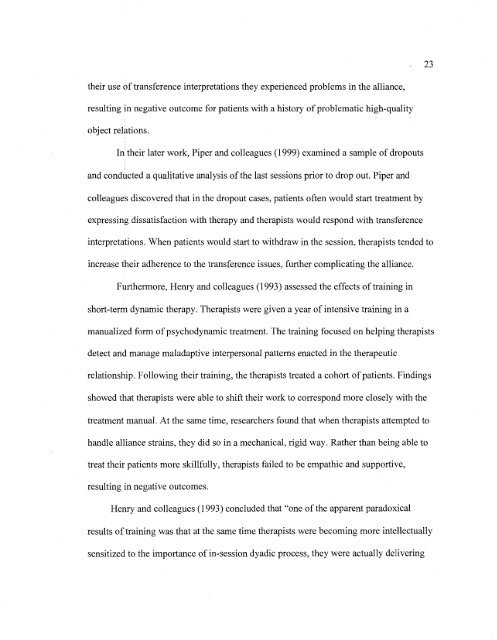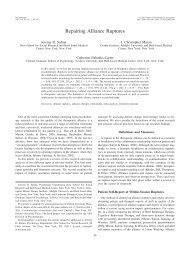Download - The Safran Lab
Download - The Safran Lab
Download - The Safran Lab
Create successful ePaper yourself
Turn your PDF publications into a flip-book with our unique Google optimized e-Paper software.
their use of transference interpretations they experienced problems in the alliance,<br />
resulting in negative outcome for patients with a history of problematic high-quality<br />
object relations.<br />
In their later work, Piper and colleagues (1999) examined a sample of dropouts<br />
and conducted a qualitative analysis of the last sessions prior to drop out. Piper and<br />
colleagues discovered that in the dropout cases, patients often would start treatment by<br />
expressing dissatisfaction with therapy and therapists would respond with transference<br />
. 23<br />
interpretations. When patients would start to withdraw in the session, therapists tended to<br />
increase their adherence to the transference issues, further complicating the alliance.<br />
Furthermore, Henry and colleagues (1993) assessed the effects of training in<br />
short-term dynamic therapy. <strong>The</strong>rapists were given a year of intensive training in a<br />
manualized form of psychodynamic treatment. <strong>The</strong> training focused on helping therapists<br />
detect and manage maladaptive interpersonal patterns enacted in the therapeutic<br />
relationship. Following their training, the therapists treated a cohort of patients. Findings<br />
showed that therapists were able to shift their work to correspond more closely with the<br />
treatment manual. At the same time, researchers found that when therapists attempted to<br />
handle alliance strains, they did so in a mechanical, rigid way. Rather than being able to<br />
treat their patients more skillfully, therapists failed to be empathic and supportive,<br />
resulting in negative outcomes.<br />
Henry and colleagues (1993) concluded that "one of the apparent paradoxical<br />
results of training was that at the same time therapists were becoming more intellectually<br />
sensitized to the importance of in-session dyadic process, they were actually delivering



